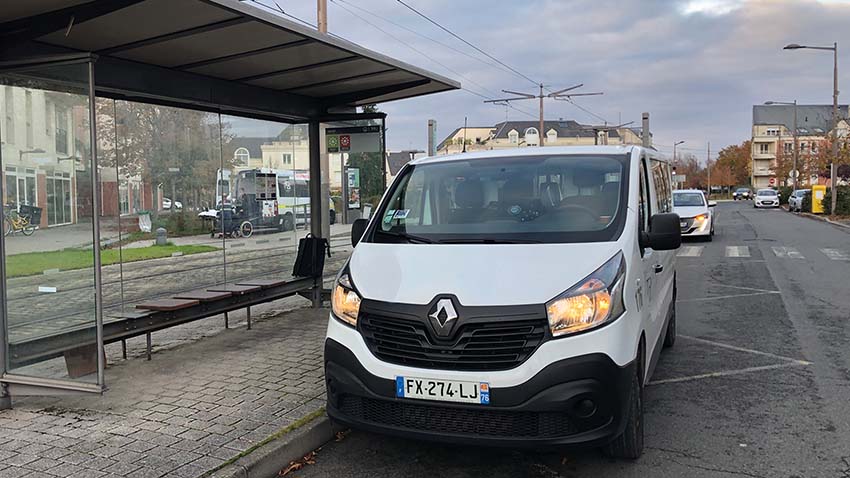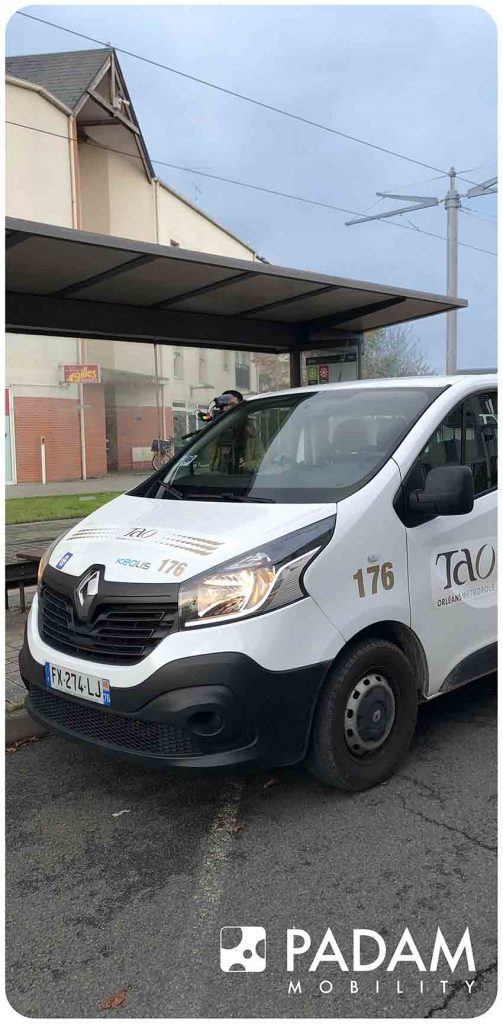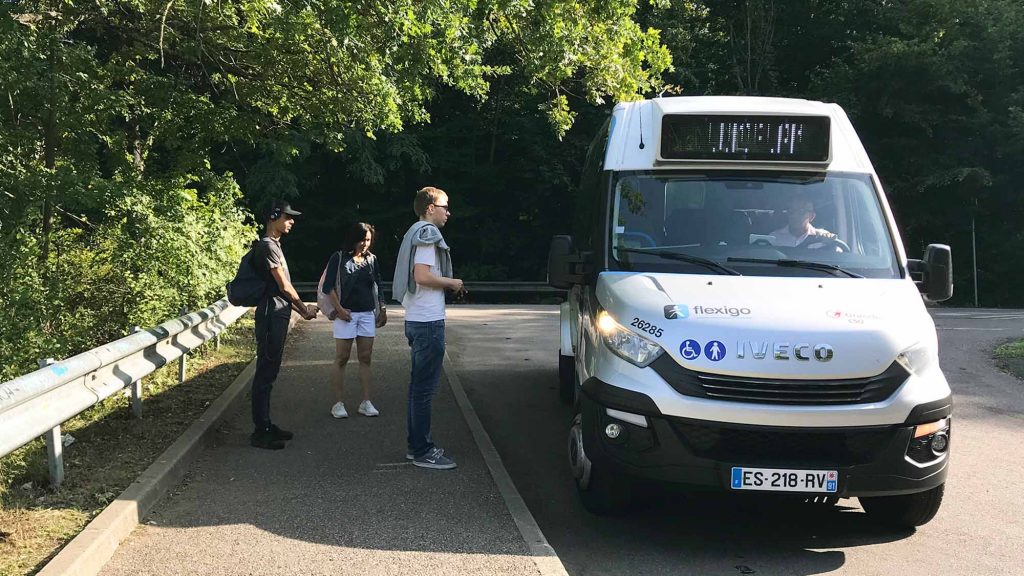Padam Mobility develops digital on-demand Public transport solutions (DRT for Demand-Responsive Transport and Paratransit) to transform peri-urban and rural territories and bring communities closer together.
Public Transport Authorities, operators and private companies trust Padam Mobility to help them open up territories, optimize the mobility offer and facilitate its operations, to accompany them towards operational excellence, and to act in favor of an environmentally-friendly mobility.
Since its creation, Padam Mobility has aimed to make smart mobility more efficient and therefore more accessible to sparsely populated areas. Taking care of the mobility of the inhabitants of peri-urban and rural areas by offering sustainable shared mobility solutions is a mission to which they respond on a daily basis by implementing on-demand transport services (DRT and Paratransit). To improve travel for all and facilitate access to services and jobs.
Padam Mobility’s solutions have proved their worth in rural areas because they:
- are easily adaptable to local issues and provide relevant answers to the problems encountered by mobility stakeholders in this scale of territory,
- make it possible to reduce the cost per trip, by increasing the attractiveness of services and therefore ridership, while at the same time reducing operating costs by minimising empty rides,
- can be adapted and integrated into a mobility offer by focusing on the most difficult part: providing a comprehensive service to users who are furthest away from the main routes.
They particularly respond to the challenges of:
- Relevance of the mobility offer
- Consideration of local constraints and adapting to different use cases
- Complementarity with the conventional public transport offer

Quality of service
- Lower operating costs and significant improvement in the performance of DRT and Paratransit services
- Simplification of call centre tasks: faster booking and processing, automatic ride dispatch
User experience and digital transition
- Reduction of booking times
- User empowerment through the introduction of new booking channels (website and mobile app)
- Improved passenger experience: real-time, multi-dates or recurring bookings, reminder notifications, ergonomic interfaces, etc.
Accessibility and sustainability
- Reduction of the carbon footprint and fine particles thanks to itinerary optimisation and ride pooling
- Adaptation to all types of vehicle fleets
- Pooling of DRT and Paratransit services for a universal and 100% accessible offer
Padam Mobility DRT and Paratransit solutions have been able to adapt to the local constraints and challenges of both the territories and their inhabitants in order to improve the mobility of rural populations, reduce their dependency on private cars and increase their autonomy in their travels.
Interview with Charles Paulino Montejo, Head of Marketing at Padam Mobility.
Easy Engineering: What are the main areas of activity of the company?
Charles Paulino Montejo: #transport #publictransport #microtransit #paratransit #demandresponsivetransport #ondemandtransport #sharemobility #saas #transportoperations #digitaltools #AI #smarttransport #maas #mobilityasaservice #softwaresolutions #softwaresuite.

Charles Paulino Montejo
E.E: What’s the news about new products?
C.P.M: Padam Mobility is continuously improving its solutions to meet the needs and challenges of both its clients (operators, public authorities, corporations) and its users. The booking, management and navigation interfaces are constantly being improved to guarantee the best ergonomic experience.
In recent months, the company has been stepping up the pace, deploying paratransit solutions adapted to the transport of people with reduced mobility (bookings considering the specific nature of PRM’s disability, presence of a specific equipment, door-to-door bookings, etc.). Reservation interfaces are also being improved to meet the market’s accessibility standards such as the French RGAA.
E.E: What are the ranges of products?
C.P.M: To enhance mobility for all, the company offers a software suite of smart and flexible solutions that improve the impact of mobility policies in sparsely populated areas for all types of users. To get users, operators and communities on the move. This software suite is based on powerful algorithms and artificial intelligence.
It includes:
- Booking interfaces (mobile app, website) for users and call centres
- A navigation interface (mobile app) for drivers
- A management interface for operators and Public Transport Authorities
- A simulation tool for designing and setting up mobility services
In parallel to the deployment of these tools, the company puts all its experience at the service of its clients at all stages of their DRT or Paratransit project (simulation, experimentation, launch, extension).
E.E: At what stage is the market where you are currently active?
C.P.M: The markets in which we operate (France, UK, Spain, Italy, Switzerland, Sweden, Germany and Canada) are at different stages of maturity. The French and UK markets are the most mature in terms of DRT and Paratransit service development, and the most competitive. Depending on the country, the contractual context may change, but most often the markets are driven by Public Transport Authorities who wish to provide real alternative mobility solutions to their constituents in sparsely populated areas.

E.E: What can you tell us about market trends?
C.P.M: Relatively similar trends can be observed in the European market:
Competitivity: there is a concentration of shared mobility players (sale, fusion, acquisition).
Product: the current challenge is integration following a MaaS logic to facilitate seamless travel from A to B. These integrations are often achieved with ticketing solutions but also with trip planners or passenger information solutions.
Service: particularly in France, we observe a real desire on the part of the geographic regions to regain control of their regional mobility offer and propose flexible services throughout their territory, in addition to the conventional transport offer such as buses or trains.
Finally, some networks in France are starting to pool their DRT and Paratransit services to guarantee a universal, inclusive and accessible offer.
E.E: What are the most innovative products marketed?
C.P.M:
Padam Mobility’s Multi-Territories architecture: a certain idea of the Mobility-as-a-Service.
The “multi-territories” architecture allows flexible management, within the same platform, of different Demand-Responsive mobility services (DRT and Paratransit) operated by one or more operators in one or more territories. The “multi-territories” solution is particularly suited to the constraints of Public Transport Authorities operating in several areas or in a multi-operated territory, allowing them to adapt the service parameters to their needs.
Thus, given the multitude of use cases in the Paris region, due to its 12,000 km2 surface area, the “multi-territories” approach has emerged as a relevant response for coordinating the DRT offer on a regional scale. A single platform has been designed for Île-de-France Mobilités (Paris region’s PTA). It is gradually being extended to include DRT services specific to one or more territories. By 2022, thanks to the “multi-territories” approach, the regional platform will be able to manage nearly 60,000 bookings per month, spread over more than 40 territories and operated by more than 10 different transport operators.

Pooling of DRT and Paratransit services
Padam Mobility’s product teams regularly consider how to pool “general public” DRT and Paratransit. The idea stems from the need of many local authorities in multi-operated areas who, rather than operating two on-demand services that pool bookings separately, want to obtain a pooled mobility service – still adapted to the transport of PRMs and meeting their specific needs – but better optimised and at a lower cost, as it simultaneously meets the needs of different audiences. This increases the possibilities of pooling rides and also offers more options: with a common fleet, users benefit from greater flexibility. A PRM vehicle will no longer make an empty ride if a request from a non-PRM user is on its itinerary. Bringing the two offers together is also useful in combating the invisibility of disability.
E.E: What estimations do you have for 2022?
C.P.M: Since its acquisition by Siemens Mobility in May 2021, Padam Mobility’s objective is to deepen its international presence, particularly in Germany and the UK. More synergies with other subsidiaries of the Siemens Mobility group such as Hacon are also planned in order to provide our clients with a real turnkey offer in the implementation of shared mobility solutions. Always in a logic of growth and strong territorial anchoring, the company plans to double its turnover and its workforce.

